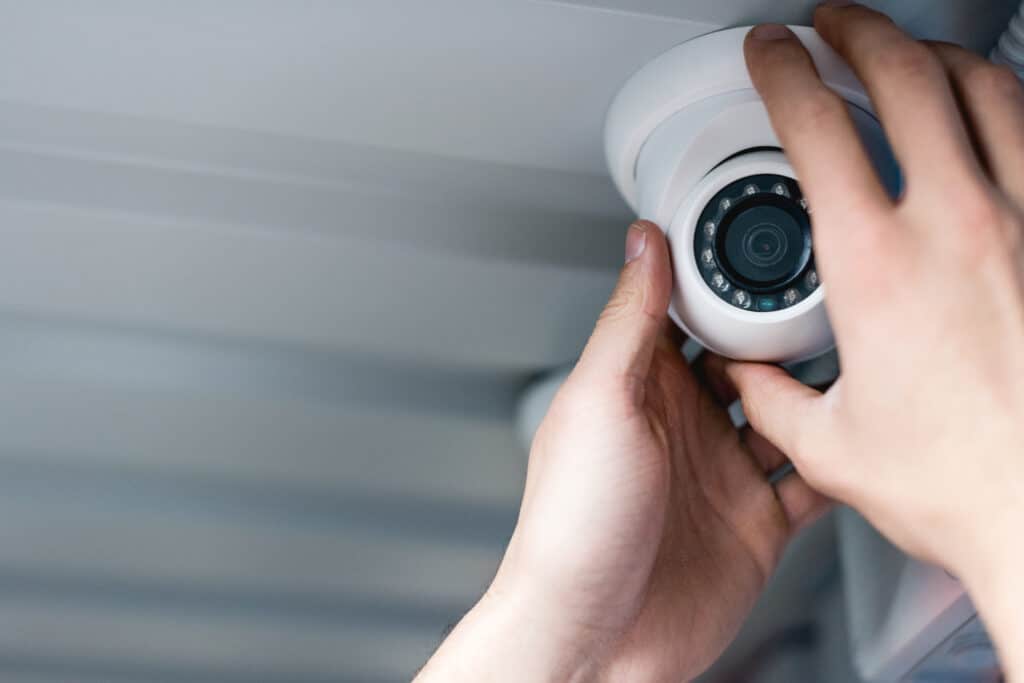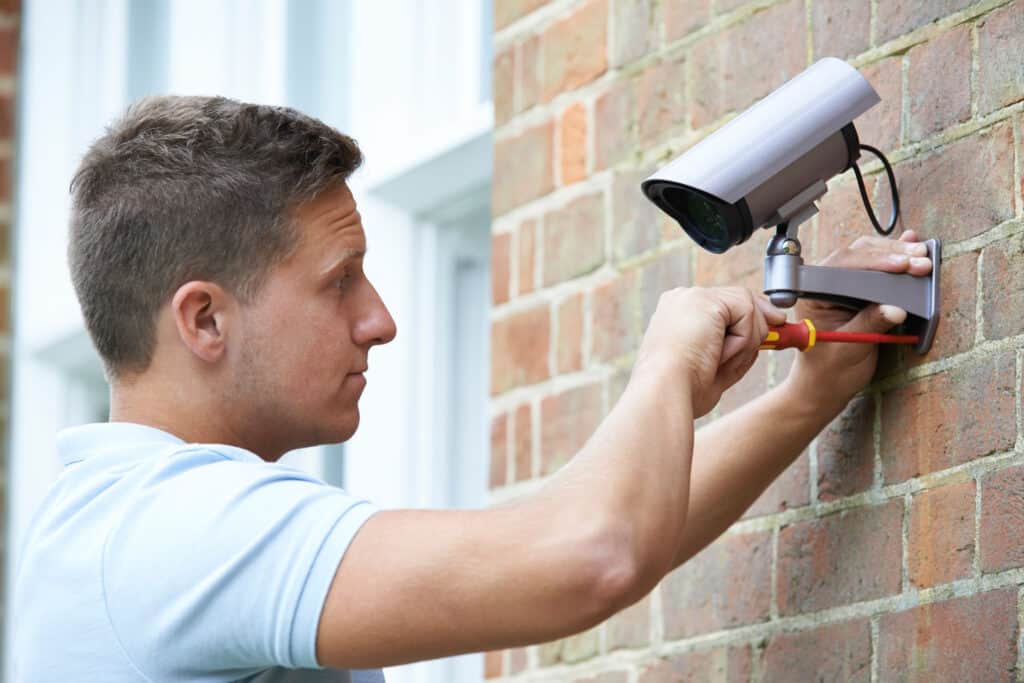In recent years, security has become a pressing concern for places of worship, including churches. One effective way to enhance the safety of sacred spaces is through the strategic installation of security cameras. Understanding where these cameras should be placed is crucial for maximizing their effectiveness in protecting the congregation and deterring potential criminal activity.
Church security cameras serve multiple purposes, from capturing incidences of vandalism and theft to providing evidence in case of accidents or disputes within the church premises. To achieve these objectives, it is important to place cameras in strategic locations that cover key areas such as entrances, parking lots, and hallways.
When installing security cameras in a church, it’s essential to strike a balance between maintaining a sense of sanctuary for worshipers and ensuring their safety. By carefully considering placement and coverage, churches can enhance their security while preserving the spiritual atmosphere that congregants cherish.
Importance of Church Security Cameras
Church security cameras play a crucial role in ensuring the safety and well-being of the congregation. They are an essential component of a comprehensive church security plan. Properly placed security cameras can help to deter theft, violence, and vandalism, while also providing valuable evidence if an incident does occur.
One of the primary benefits of having security cameras in a church is the deterrent effect they can have on potential criminals. The mere presence of cameras can discourage individuals from engaging in theft or other misconduct, thereby contributing to a safer environment for worshippers and staff. Additionally, the installation of cameras can help to protect church property and valuable belongings, which is particularly important in a place where people gather to worship and find refuge from the outside world.
In cases where incidents do occur, security cameras can provide crucial evidence to help law enforcement investigate and resolve the situation. This evidence can be critical in identifying perpetrators and supporting legal proceedings if needed. Moreover, the footage can aid church leaders in understanding the circumstances surrounding the event and informing their security measures moving forward.
Security cameras can also help to monitor and prevent acts of violence or vandalism within the church property. Ensuring the safety of the congregation is a top priority for any religious institution, and security measures such as cameras can mitigate the risk of violent incidents or abusive behavior. In the unfortunate event of damage or violence within the church, immediate access to video footage can help security staff and law enforcement assess and address the situation more effectively.
In summary, the importance of church security cameras cannot be overstated. By providing deterrence, evidence, and monitoring capabilities, they contribute to a safer and more secure environment for the congregation and staff alike. As part of a well-rounded church security strategy, security cameras can play a vital role in maintaining the sanctity and safety of religious institutions.
Types of Security Cameras for Churches
There is a multitude of security camera options available for churches, each offering various features and capabilities. In order to effectively cover different areas and ensure the safety of the premises, it is essential to carefully assess the specific requirements of the church and provide tailored solutions. Here we discuss various types of security cameras suitable for church environments:
Dome Cameras are widely used in churches due to their discreet and vandal-resistant design. These cameras are typically ceiling-mounted and provide a wide field of view, making them ideal for monitoring larger areas like the congregation hall. Dome cameras come in various shapes and sizes, with some offering infrared or night vision capabilities for around-the-clock surveillance.
PTZ Cameras (Pan-Tilt-Zoom) offer flexibility and versatility, enabling operators to remotely control their movement and focus on specific areas or incidents. This makes them effective in monitoring larger spaces both indoors and outdoors, such as parking lots and entrance areas. PTZ cameras can be programmed for automatic tours or operated manually, allowing for real-time coverage of events and potential threats.
Church Wireless Surveillance Cameras offer the advantage of easy and quick installation in areas with WiFi signal. These cameras transmit video signals wirelessly and do not require extensive wiring, making them ideal for retrofitting into existing infrastructure or temporary installations. However, it is crucial to ensure that the selected wireless security system offers stable internet connectivity to guarantee reliable and uninterrupted performance.
Church PoE Security Cameras (Power over Ethernet) are wired security cameras that leverage Ethernet cables to transmit both video data and power. This simplifies the installation process, as there is no need for separate power cables, and offers a more reliable and secure connection than wireless cameras. PoE cameras are suitable for both indoor and outdoor use, providing constant coverage in various locations throughout the church premises.
PTZ HD Security Cameras combine the advantages of PTZ cameras with high-definition video resolution, capturing clear and detailed footage for better identification and analysis. These cameras allow operators to zoom in on specific areas without losing image quality, enhancing the overall security and effectiveness of the surveillance system.
In summary, a variety of security cameras can be utilized to meet the unique needs of church environments. From discreet dome cameras to versatile PTZ cameras and reliable PoE systems, it is essential to carefully consider the specific surveillance requirements of the church and select the most suitable combination of cameras to ensure optimal security coverage.
Technologies and Features
When it comes to church security camera systems, there are several technologies and features to consider. One of the most crucial factors is the type of security camera system used, which typically falls into three categories: analog, IP (internet protocol), and hybrid surveillance installations. Each system offers specific advantages and can be tailored to the unique needs of a church’s security.
Analog surveillance installations are the traditional technology used for security cameras. They utilize analog cameras that transmit video signals over coaxial cables to a video recorder. Despite their relatively older technology, analog systems provide a reliable and cost-effective solution for churches with a limited budget or for locations where network connectivity is not readily available.
IP surveillance installations, on the other hand, are more advanced systems that use digital cameras connected to a network. These systems allow for remote monitoring, as the video is transmitted over the internet rather than through physical cables. This feature enables security teams and church administrators to keep an eye on the church grounds from their computers or mobile devices. With an IP surveillance system in place, video analytics platforms can also be integrated to provide additional layers of security, such as facial recognition or motion detection capabilities.
Hybrid surveillance installations combine both analog and IP camera systems, offering the flexibility to use existing analog cameras alongside newer IP cameras. It can be an ideal solution for churches that are transitioning from an analog system to a digital one or for locations in which specific areas require different types of cameras.
When selecting security cameras, night vision capabilities should be considered, as it will allow for clear surveillance in low light conditions or during the night. Many modern security cameras come equipped with infrared technology, which can detect body heat, further enhancing the effectiveness of night vision.
Audio recording is another feature that can be beneficial in a church security camera system, as it allows for the capture of conversations or noises that could be relevant to an investigation. However, it’s essential to be aware of local laws and regulations when implementing audio recordings, as there may be privacy implications.
In conclusion, various technologies and features can be incorporated into a church security camera system, offering tailored solutions for different requirements. By combining the right mix of components, such as analog or IP surveillance systems, night vision capabilities, audio recording, and remote monitoring options, churches can provide a safer environment for their congregation and staff.
Camera Placement and Coverage Areas
When installing security cameras in places of worship, it is crucial to consider both indoor and outdoor coverage to ensure the safety of the entire infrastructure. A well-designed camera network will provide comprehensive surveillance, helping to deter potential criminal activities and safeguard the church’s property and congregation.
For indoor coverage, focus on entry points, such as main doors, side doors, and windows. By placing cameras near these access areas, it becomes easier to monitor who enters and exits the building. Additionally, consider installing cameras in high-traffic areas, such as the sanctuary, hallways, and common gathering spaces. Proper lighting is essential for capturing clear images, so make sure to position cameras in well-lit areas or use cameras with night-vision capabilities.
Outdoors, prioritize the placement of cameras in parking lots, walkways, and other exterior access points. These are common areas for criminal activities or vandalism to occur. Monitoring these locations can help to deter potential threats and provide important information in the case of an incident. Take note of natural barriers, like trees or bushes, and make sure cameras have an unobstructed view of their coverage area.
When positioning security cameras, always consider the network infrastructure and power availability. Cameras should be connected to a reliable network to ensure uninterrupted surveillance. Wireless cameras can make installation more flexible, but it is essential to provide a strong Wi-Fi signal to maintain consistent footage quality.
In conclusion, thorough planning and strategic camera placement in places of worship will create a secure environment both indoors and outdoors. Paying attention to entry points, high-traffic areas, and exterior locations, combined with sufficient lighting and network support, will contribute to an efficient, comprehensive security system.
Benefits and Considerations
Church security cameras can provide numerous benefits while also raising some considerations that need to be addressed. The inclusion of surveillance equipment within a place of worship can be invaluable in terms of safety and security.
One of the primary benefits of security cameras is their ability to deter crime. Criminals are less likely to target facilities that have visible security measures in place, such as video surveillance. This can help to reduce incidents such as burglary or vandalism, and ultimately contribute to the overall peace of mind for members of the congregation. Furthermore, having access to video footage can aid in resolving disputes and identifying suspicious activity quickly and efficiently.
Security cameras can also play a key role in helping to identify and prevent potential injuries within the church premises. For example, in the event of a slip and fall accident or any other safety hazard, video surveillance can provide evidence of the cause and help officials take the necessary steps to prevent future incidents. This not only improves overall safety but can significantly reduce liability concerns for the church.
While the benefits are certainly compelling, it’s essential to also consider the privacy concerns surrounding surveillance in places of worship. Many people view churches as sanctuaries and feel that the presence of cameras interferes with that sense of sanctity. Striking a balance between preserving the atmosphere in public places and maintaining safety and security is crucial to avoid alienating congregation members and visitors alike.
In conclusion, installing security cameras within church premises comes with many significant advantages, including crime deterrence, improved safety, and dispute resolution. However, it’s essential to balance these benefits with the need to respect the privacy and sanctity of these public spaces. Overall, careful planning and thoughtful placement of surveillance equipment can ensure that the church remains a safe and secure place for worship while respecting the privacy of its visitors.
Privacy and Legal Issues

When installing security cameras in a church, it is essential to consider privacy and legal issues surrounding their use. The primary aspect to be aware of is the reasonable expectation of privacy. Security cameras should only be placed in areas where individuals do not have a reasonable expectation of privacy, such as the church’s exterior, entrances, hallways, or common areas.
One crucial aspect of church security is maintaining a balance between adequate surveillance and ensuring the congregation’s privacy. It is important to create and implement comprehensive policies that outline the specific use and maintenance of security cameras. These policies should be communicated to the church members and staff, as well as enforced by designated security personnel.
In some jurisdictions, it may be required or recommended to notify individuals when they are being recorded. If this is the case, clearly posted signs can be used to inform visitors about the presence of security cameras and their purpose. This helps to uphold transparency while reinforcing the church’s commitment to safety and security.
In the event of an incident, it is important to know how to cooperate with law enforcement and provide them with the necessary information. This may involve sharing security camera footage upon request with the police to assist in an investigation. As part of their policies, churches should establish guidelines for securely storing and managing camera recordings to ensure they are accessible when needed and compliant with relevant data protection regulations.
In summary, to avoid legal issues and respect individuals’ privacy when installing church security cameras, it is vital to consider camera placement, implement clear policies, ensure proper notification, and work collaboratively with local law enforcement. Doing so will create a safe and secure environment for worship while maintaining trust and transparency within the church community.
Developing a Church Security Plan
Developing a comprehensive church security plan is crucial for religious organizations to protect their congregations, staff, and facilities. A well-thought-out security plan addresses various threats and vulnerabilities and ensures the safety and security of everyone involved.
The first step in creating a robust security plan is to assess the unique risks your religious organization faces. This risk assessment process should include evaluating the layout of the building, the surrounding area, and the likelihood of specific threats, such as theft, vandalism, and violent incidents. It is helpful to engage church leaders, staff, and security or law enforcement professionals in this process to ensure a thorough understanding of potential risks.
An essential aspect of a church security plan is having a dedicated security team or working with professionals for guidance and implementation. Staff members and volunteers should receive proper training in emergency response procedures, first aid, and violence prevention. Regular meetings and communication between church leaders and the security team can help ensure that everyone is on the same page in terms of safety practices.
One key consideration for your security plan is installing security cameras and alarm systems within the church and around its premises. The placement of cameras should provide optimal coverage of entrances, exits, hallways, daycare or children’s areas, and any valuable assets, such as artwork or equipment. Monitored access systems can also be beneficial in controlling access to restricted areas and enhancing overall security measures.
Establishing relationships with first responders, such as the local police department or the FBI, can be invaluable in building your church security plan. Sharing information with them will help you stay up-to-date on local threats and improve your organization’s ability to protect itself. The same holds for partnerships with neighboring organizations, as a united community can collectively enhance safety measures.
Lastly, it is crucial to regularly review and update the church security plan as necessary. Schedule periodic evaluations of your plan and make adjustments based on new information, trends, or significant changes within your organization. It’s essential to remain proactive in maintaining the security and safety of your religious community and paying close attention to new technologies and best practices in the field.
Remember, the ultimate goal is to provide a safe and welcoming environment for worship and fellowship. Developing a well-planned and maintained security strategy helps ensure ongoing protection and peace of mind for your religious organization.
Implementing Security Systems and Support
Implementing a robust security system in a church is essential to ensure the safety of its congregation and the protection of valuable assets. One of the critical aspects of a comprehensive security system is the strategic placement of security cameras. In addition to cameras, churches can benefit from other security measures, such as window alarms, access control installation, and alarm system integration.
When planning for the installation of security cameras, it is essential to consider areas such as entrances and exits, adjacent parking lots, and any remote or secluded areas of the property. Integrating video alarms with these cameras can help alert the security team of any suspicious activity, enabling them to act swiftly.
Access control installation is another important facet of church security, allowing the management to restrict entry to authorized personnel and keep track of people’s movements within the premises. Incorporating access control with surveillance systems can provide a cohesive security approach, ensuring all potential weak points are covered.
In cases where a church already has a security system in place, it might require a complete system rewiring or a systems upgrade to enhance its performance. A1 Security Cameras is a reliable provider that offers comprehensive solutions for implementing security measures at places of worship, including surveillance cameras, access control, and alarm systems.
It’s crucial to ensure that security equipment, including cameras and alarms, is configured correctly and integrated with the existing system for optimal performance. Having your alarm system seamlessly integrated with other security components improves efficiency and effectiveness, providing better safety coverage for the church community.
In conclusion, setting up a church security system involves careful planning and integration of various security elements such as security cameras, window alarms, access control installations, and alarm system integration. Regular maintenance and systems upgrades should also be considered to keep the security system up-to-date and effective for years to come.
Involving Stakeholders and Volunteers
When planning the installation of security cameras for a church, it is vital to involve stakeholders and volunteers in the process. This ensures that different viewpoints and perspectives are considered during the decision-making stage and allows for a more comprehensive understanding of the church’s security needs.
One of the first steps in involving stakeholders and volunteers is to assess the likelihood of various incidents that the church may face. These may include active shooter events, terrorism, car accidents, or even more routine occurrences such as theft or vandalism. With this information, the security team can prioritize which areas require the most attention and plan for appropriate procedures in response.
In addition to considering potential incidents, it is essential to involve key personnel from within the church community, such as firefighters, security team members, and other volunteers. These individuals can provide valuable insight into the church’s specific needs and help ensure that the security plan is feasible and practical. By involving these stakeholders early in the process, they can assist in developing and implementing effective and customized security measures.
To further involve stakeholders and volunteers, the security team can utilize remote access technology to provide a virtual tour of the church’s facilities. This allows those involved to visually inspect the proposed locations for security cameras and to identify any potential blind spots or areas of concern. By facilitating this type of virtual involvement, the security team ensures that all perspectives are taken into account when designing the security camera system.
Moreover, church security extends beyond the main worship areas and into schools, daycare centers, and recreational facilities located on church grounds. As such, the security team should work closely with representatives from these various areas to ensure that all aspects of the church’s property are secured and monitored appropriately.
Lastly, a vital aspect of church security is maintaining a carefully managed inventory of all security cameras and related equipment. By keeping an up-to-date inventory, the security team can quickly identify and address any issues or malfunctions, ensuring that the church’s surveillance system remains effective and reliable.
In conclusion, involving stakeholders and volunteers in the planning and implementation of church security measures can greatly enhance the overall effectiveness of the security camera system. By taking into account various perspectives, priorities, and needs, the church can develop a security plan that addresses potential incidents and safeguards its community.
Frequently Asked Questions
What are the top security camera systems for churches?
There are various security camera systems available that cater to the specific needs of churches. Top solutions like Deep Sentinel, and others, offer live monitoring and high accuracy, ensuring swift intervention and expedited law enforcement involvement when necessary. The choice ultimately depends on factors such as budget, property size, and security requirements.
How are security cameras installed in churches?
Security cameras are typically installed by professionals who assess the church’s layout and security needs, determining the most effective locations for cameras. Cameras should be placed in high-traffic areas, vulnerable spots, and entry points. Each camera’s function and the total number of cameras needed will depend on the church’s unique circumstances and goals.
What is the legal aspect of having security cameras in churches?
It is crucial for churches to comply with local laws and regulations when installing and using security cameras. Privacy rights must be respected, which means adhering to guidelines on where cameras can be placed and how recorded footage can be stored. Churches may also need to display signs informing individuals that they are entering an area with video surveillance.
How long is security footage retained in church systems?
Retention policies for security footage in churches vary based on factors like storage capacity, legal requirements, and a church’s unique security needs. Some churches may retain footage for as little as a week, while others may store it for months or even years. Churches should develop a clear retention policy to avoid retaining unnecessary footage and to ensure compliance with applicable laws.
Are security cameras typically placed inside or outside churches?
Security cameras are generally placed both inside and outside churches. Exterior cameras can monitor entry points and parking lots, while interior cameras can cover halls, sanctuaries, and offices. Balancing interior and exterior coverage ensures overall security and can help deter or capture inappropriate activities.
What advantages do security cameras provide for church safety?
Installing security cameras in churches offers several benefits, including crime deterrence, evidence gathering in case of incidents, and increased safety for congregants and staff. Well-placed cameras can help identify potential threats and prevent incidents before they escalate, fostering a sense of security and well-being within the church community.








